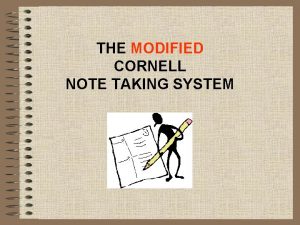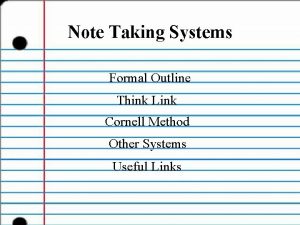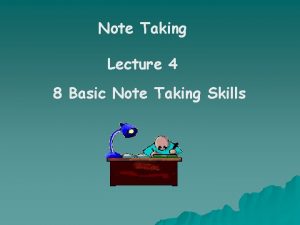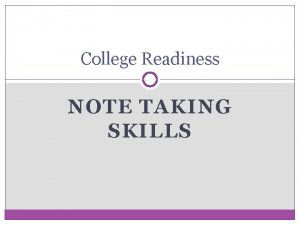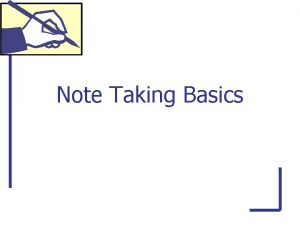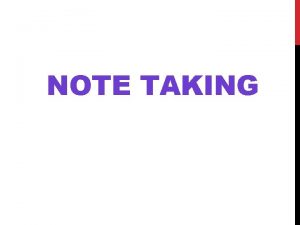TRi O Student Support Services Note Taking Student











![Graphic Signals: Time saving symbols [ ], ( ), information that belongs together *, Graphic Signals: Time saving symbols [ ], ( ), information that belongs together *,](https://slidetodoc.com/presentation_image_h2/80918ad8c25f939a3d468f2f7eb34fdd/image-12.jpg)

- Slides: 13

TRi. O Student Support Services Note Taking Student Support Services is a Title IV TRi. O Program funded by the U. S. Department of Education. All services are FREE to qualified students.

Note Taking Process: Three Parts Observing Recording Reviewing

Observe: Ø Ø Ø see facts, relationships, events, and statements Set the stage Be focused in class Watch for clues

Set the stage ü ü Complete outside assignments Bring the right materials Sit front and center Conduct a short pre-class review

Be Focused in Class Ø Ø Ø Accept your wandering mind Be with the instructor Participate in class activities Relate the class to your goals Think critically about what you hear

Watch for clues Ø Ø Ø Be alert to repetition Listen for introductory, concluding, and transition words and phrases Watch the board or overhead projector Watch the instructor’s eyes Highlight the obvious clues Notice the instructor’s interest level

Record: • • • Write Your Observation -- Take Notes Use the Cornell format of note taking Create mind maps Write notes in outline form Use key words Use pictures and diagrams Write notes in paragraphs Copy material from the board Use a three-ring binder Use only one side of a piece of paper Use 3 x 5 cards

Record: • • • continued Keep your own thoughts separate Use an “I'm lost” signal Label, number, and date all notes Use standard abbreviations Use blank space Use tape recorders effectively Use complete sentences when material is important Take notes in different colors Use graphic signals

Review ü ü ü ü Review within 24 hours Edit notes Fill in key words in the left-hand column Conduct short weekly review periods Use your key words as cues to recite Consider typing your notes Create mind map summaries

Cornell Method: Key Word Divisions of Nervous System CNS PNS Example Subject Notes Neuroanatomy: Divisions of the Nervous System The nervous system can be divided into “systems”. These systems are connected and function together. The Nervous System is divided into: The Central Nervous System and the Peripheral Nervous System. The Central Nervous System is divided into two major parts: the brain and the spinal chord. The Peripheral Nervous System is divided into two major parts, the somatic nervous system and the autonomic nervous system.

Mind Map Method: Visual representation to aid in memory retention Central Nervous System Brain Spinal Cord
![Graphic Signals Time saving symbols information that belongs together Graphic Signals: Time saving symbols [ ], ( ), information that belongs together *,](https://slidetodoc.com/presentation_image_h2/80918ad8c25f939a3d468f2f7eb34fdd/image-12.jpg)
Graphic Signals: Time saving symbols [ ], ( ), information that belongs together *, important information ** !!! Extra important > greater than < less than = equal to Ex: school ? huh / lost ? ? big trouble, clear up immediately

The End I hope you enjoyed this presentation. Please feel free to stop by the TRi. O office suites and visit with us.
 Licenze poetiche palazzeschi
Licenze poetiche palazzeschi Crepuscolari
Crepuscolari Difference between note making and note taking
Difference between note making and note taking Signal word
Signal word Difference between note making and note taking
Difference between note making and note taking Relevance of note making
Relevance of note making Cornell note questions
Cornell note questions Outline method of note taking
Outline method of note taking Section 17-3 note taking guide answer key
Section 17-3 note taking guide answer key What are the five r's of note taking
What are the five r's of note taking What are the 5 r's of note taking
What are the 5 r's of note taking Note taking process
Note taking process Outline method of note taking
Outline method of note taking 5 r's of note taking
5 r's of note taking






